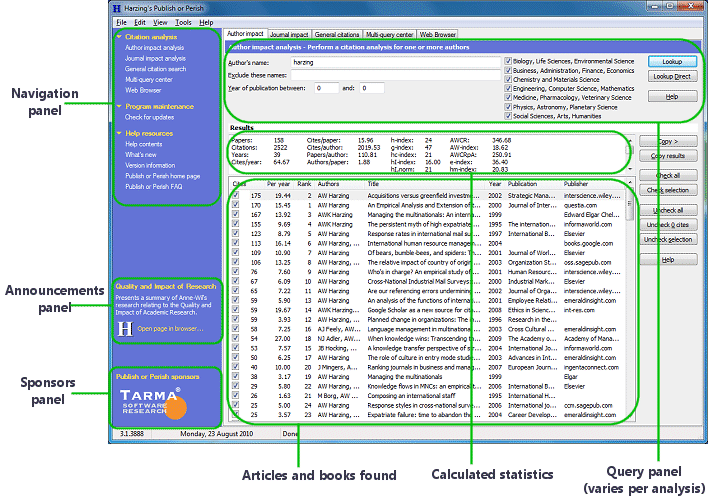Using Publish or Perish
To use Publish or Perish (PoP), you need a working Internet connection. PoP uses Google Scholar queries to obtain citation information, which is then analyzed and converted to a number of statistics. The results are available on-screen and can also be copied to the Windows clipboard (for pasting into other applications) or saved to a text file (for future reference or further analysis).
Main window
The most important areas in the Publish or Perish main window are shown below.

- Navigation panel
- This area contains the links to the citation analysis pages and various program resources. Click on a link to go to the indicated page or perform the action. The section headers can be collapsed by clicking on the headers; they can be restored by another click on the same header line.
- Announcements panel
- This area displays announcements about the Publish or Perish software or related topics, such as citation analysis. To read more about a specific announcement topic, click on the More information... link.
- Sponsors panel
- This area displays logos of the sponsors who supported the development of the Publish or Perish software. Click on a logo to visit the sponsor's web site.
- Articles and books found
- This area displays the list of articles and books that matched the search query. Refer to the Results pane topic for more information about this area.
- Calculated statistics
- This area displays the statistics that were calculated from the results returned by the search query, subject to the selection status of the items in the lower list. Refer to the Results pane topic for more information about this area.
- Query panel
- This area contains the entry fields for the search query. The available fields depend on the type of search; see below for more information about these search types.
- Status bar
- As of Publish or Perish release 3.6.4422, the status bar displays the number of HTTP requests that were sent to Google Scholar during the last 5 minutes, the last 4 hours, and in total. Only "over the wire" requests are counted; queries that could be satisfied from the local cache are not included. The HTTP request rate display is intended to help you avoid sending too many queries to Google Scholar in too short a time, which might cause further requests to be blocked.

Search types
Please refer to the following topics for details about the various search types:
To manage sets of queries, consult the Multi-query center help topic.
To export the resulting data, see Exporting the data.
Background information
For important background information about the use of Publish or Perish, see:
Reference information
For reference information, see: